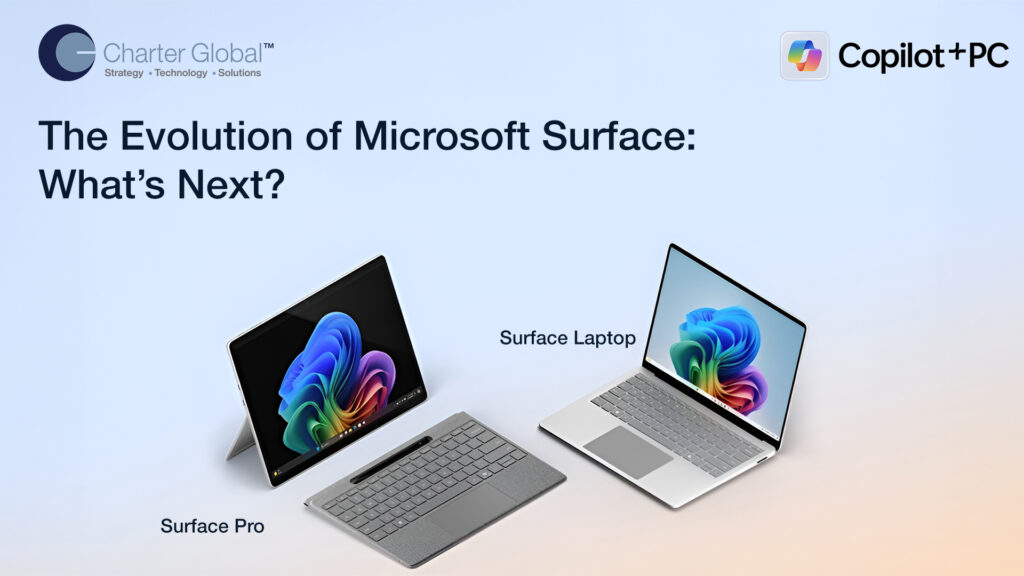Since its introduction in 2012, Microsoft Surface has redefined what’s possible with hybrid computing. What began as an ambitious attempt to merge the power of a laptop with the portability of a tablet has evolved into an extensive lineup of devices tailored for professionals, creatives, and enterprise users. Today, the Surface ecosystem includes everything from ultra-light 2-in-1 devices to powerful workstations, making it an integral part of modern workplaces. As a trusted Microsoft partner, Charter Global helps businesses integrate Surface devices into their digital transformation strategies, ensuring seamless deployment and maximum efficiency.

A Look at the Evolution of Microsoft Surface
The Microsoft Surface lineup has undergone significant advancements in design, performance, and usability. Here’s a closer look at how the Surface family has evolved over the years:
1. Early Generations: Laying the Foundation
- The first-generation Surface RT (2012) was an experiment in blending the tablet experience with Windows. While it had limitations due to Windows RT, it set the stage for future innovations.
- The Surface Pro series, introduced in 2013, provided a more powerful alternative, running full Windows OS and offering compatibility with legacy applications.
2. Expanding the Ecosystem: Versatility and Power
- The launch of Surface Book (2015) brought a detachable laptop with dedicated graphics, targeting creative professionals.
- Surface Studio (2016) introduced an all-in-one PC with a touch-enabled display designed for digital artists and architects.
- Surface Go (2018) made Surface devices more accessible with a compact, budget-friendly option ideal for students and mobile professionals.
3. Modern Advancements: Performance, AI, and 5G Connectivity
- Surface Pro X (2019) debuted an ARM-based processor, offering longer battery life and always-on LTE connectivity.
- Surface Laptop Studio (2021) introduced a unique hinge design, allowing users to shift between laptop, tablet, and studio modes seamlessly.
- Surface Pro 9 (2022) and Surface Laptop 5 improved performance with Intel’s latest chips, faster refresh rates, and optimized power efficiency.
The Latest Surface Devices: What’s New?
Microsoft continues to push boundaries with its latest Surface lineup. Here are some of the standout features of the most recent devices:
- Surface Laptop Studio 2 – A powerhouse device for designers and developers, featuring NVIDIA RTX graphics, Intel Core i7 processors, and an adaptive hinge for flexible use.
- Surface Pro 9 with 5G – Enhanced connectivity and AI-powered enhancements like voice clarity and background blur in Microsoft Teams.
- Surface Go 4 – An affordable yet capable device tailored for frontline workers and students needing portability without sacrificing performance.
- Surface Hub 3 – A reimagined digital whiteboard for enterprises, designed to enhance hybrid collaboration with Teams integration.
Future Predictions: What’s Next for Microsoft Surface?
As technology rapidly advances, Microsoft is expected to continue innovating within the Surface ecosystem. Here are some predictions for the future:
1. AI-Powered Enhancements
- Integration of AI-powered assistants, making Surface devices more intuitive and adaptive to user needs.
- Improved AI-based battery management, extending device longevity through intelligent power consumption.
2. Advancements in Foldable and Dual-Screen Technology
- Microsoft has experimented with dual-screen technology in the past (Surface Duo), and we may see more refined versions with foldable OLED displays.
3. Next-Generation Chipsets
- The industry is shifting toward ARM-based processors with enhanced power efficiency. Future Surface devices could feature Microsoft’s custom silicon, improving performance and battery life.
4. Greater Integration with Cloud and Edge Computing
- Expect deeper integration between Surface devices and Microsoft Cloud services like Azure, allowing for real-time data processing and AI-driven insights.
5. Enhanced Sustainability Initiatives
- Microsoft has committed to reducing its carbon footprint, and future Surface devices are likely to incorporate more recyclable materials and energy-efficient components.
Why Businesses Should Invest in Microsoft Surface
For enterprises, Surface devices offer a unique combination of power, security, and flexibility. Some key benefits include:
- Seamless Integration with Microsoft 365 – Ensuring a smooth workflow with Office apps, Teams, and OneDrive.
- Enterprise-Grade Security – Features like TPM chips, Windows Hello, and Microsoft Defender ensure data protection.
- Versatility for Hybrid Work Environments – Adaptable designs support employees working remotely or in the office.
- Long-Term Cost Efficiency – Durable builds and long software support lifecycles reduce overall IT expenditures.
Conclusion
Microsoft Surface continues to shape the future of computing with groundbreaking innovations, making it an ideal choice for businesses looking to stay ahead of the curve. As a Microsoft partner, Charter Global specializes in helping organizations integrate Surface devices into their operations, ensuring optimized performance and a seamless transition. To explore how Microsoft Surface can enhance your business, book a consultation today. Email us at [email protected] or call us at 770-326-9933.
